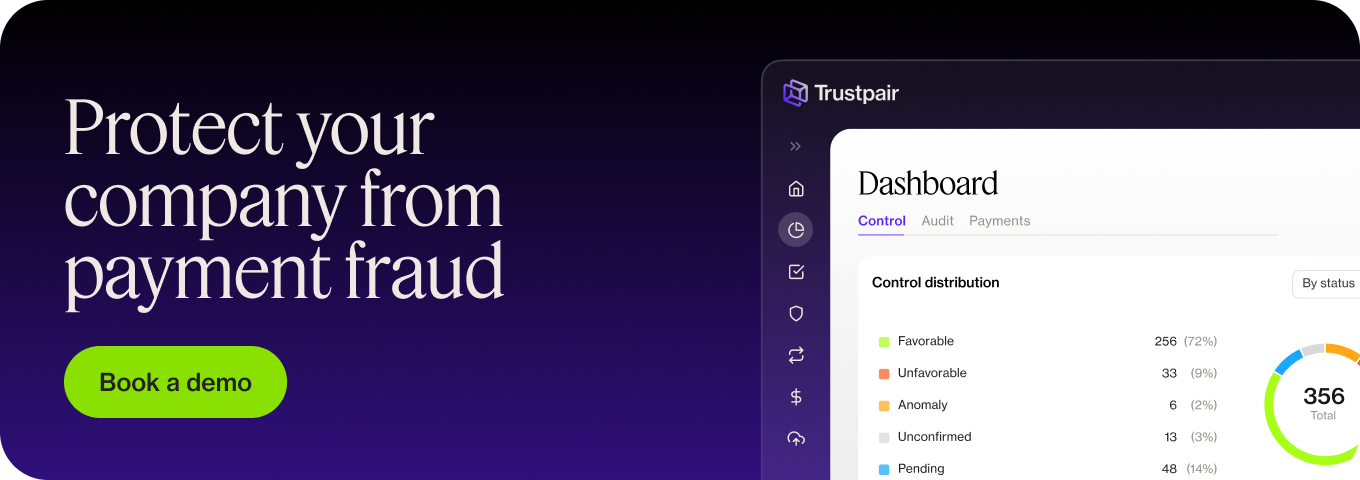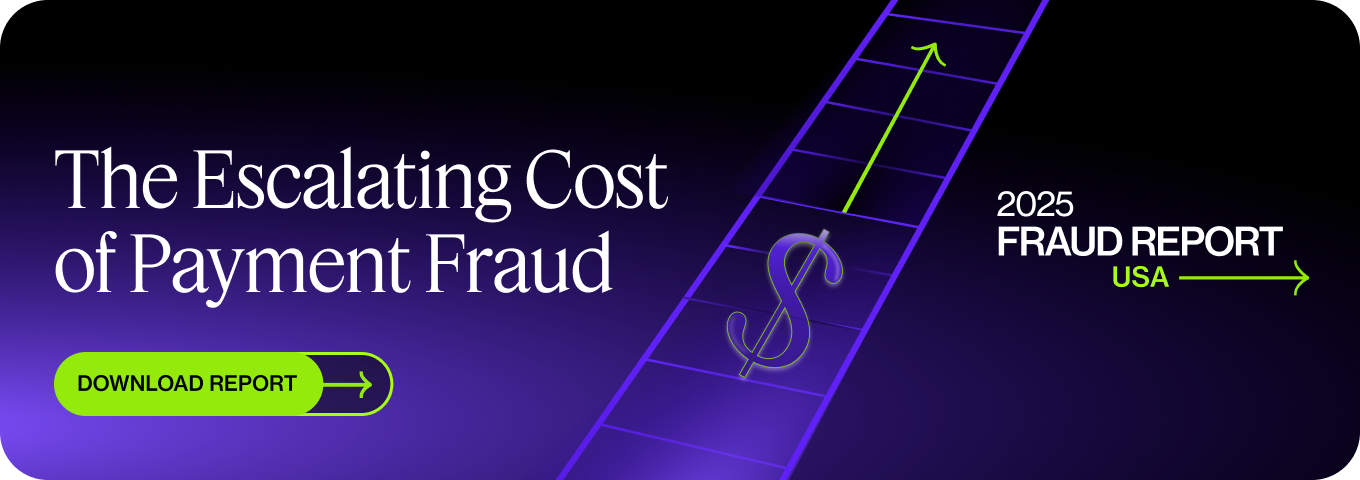Strategies for successful fraud management are out there, but it seems that companies don’t seem to know enough about them because rates of fraud are still on the rise. With data, financial security, and your company’s reputation at risk, isn’t it time to cover your back and develop a bulletproof strategy against fraud? In this article, learn all there is to know about the 5 risk management principles to have an effective and proactive approach to fraud.
Trustpair is a fraud prevention solution and has been providing effective b2b fraud management to clients since 2017. Contact an expert to learn more!
Conduct a thorough fraud risk assessment
Risk is one of the most accurate predictors of fraud. After identifying risks, your team can work to reduce their likelihood and the overall risk of fraud on the business. Risk assessments to fight fraud should focus on three factors:
- Identifying risks
- Likelihood of occurrence
- Potential impacts
Identifying risks
Identifying risks in terms of fraud means using data analysis techniques throughout your entire organization to determine where the vulnerabilities lie. For example, if your supplier payment process relies on email communication, there is potential for exposure to get compromised or intercepted, and for vendor fraud to take place.
It’s all about mapping out the weaknesses of your processes and identifying how criminals could benefit from them to commit fraud.
Likelihood of occurrence
When calculating the likelihood of occurrence, your team can evaluate the fraud control in place, and how easy it would be for a perpetrator to carry out each crime. For example, it’s much harder for cybercriminals to hack your systems if you have an upgraded firewall. With an anti-fraud security platform, the likelihood of occurrence would be low.
Potential Impacts
Finally, the impacts are potentially the most important evaluation in fraud risk management. Here, your team will have to determine the legal (or regulatory) consequences, financial consequences, and reputational impacts of potential financial crimes.
Executives from Twitter fell victim to a business email compromise scam in 2020. The failure to identify suspicious activity led to significant financial damage (totaling almost $120k worth of counterfeit cryptocurrencies). Along with public concerns and a decline in investor confidence, the stock took a tumble.
Set up specific fraud governance policies
Fraud governance means setting up measures inside your organization to prevent fraud, like how often employees should change their passwords.
By involving your senior executives from the very beginning, fraud mitigation governance sets the company culture with regard to fraud from the top. Moreover, having the buy-in from leadership ensures that policies will likely be followed more closely.
One example of a fraud governance policy is to encourage employees to report suspicious behavior. Let’s say a supplier requests to change their payment details out of the blue in a phishing scam. Without a specific supplier risk management policy, your employee may not know how to verify and authenticate merchants’ details or report this suspicious activity. Thus, companies may fall into the trap of making payments to fraudsters who impersonate your real third parties.
By building a fraud governance framework, your organization’s fraud management practices can be coordinated. Knowing which law enforcement agency to call, for example, can be the difference between getting a refund and never seeing the money again. A strong governance framework can help your fraud analyst manage risk assessments and underpin the anti-fraud training to further protect yourself.
Choose the right prevention methods and tools
No matter how aware you are about the risks, or building good policies, without the right tools to actually prevent fraudulent activities from happening, your business is still vulnerable.
So what are the right prevention methods and tools to protect against fraud?
At Trustpair, a dedicated b2b payment fraud protection platform, we recommend several reliable strategies:
- Fraud awareness program
- Automated checks
- Elimination of check payments
- Controls built into the ERP system
Fraud awareness program
In our recent study, 60% of surveyed professionals thought that a good fraud awareness program was the best approach to prevention and detection. A good fraud awareness program can minimize fraud risks, but it’s not the be-all, end-all. That’s because a manual and “human-only” approach isn’t enough when faced with the sophistication of fraudsters.
Download our full study about fraud in the US right here!
Automated checks
Automated account validation can provide a higher level of confidence in the fight against fraud. For example, Trustpair facilitates the automatic validation of vendor account details, including company information, blacklisted companies, and banking information. This ensures that your new suppliers are who they say they are, eliminating the risk of payment fraud.
Elimination of check payments
Check payments are the most insecure method of payment. When Trustpair CEO, Baptiste Collot, was asked about the state of check fraud, he said this,
“It’s no wonder check fraud is the most common type of payment fraud: it’s very hard to fight! A digital alternative will make it easier to detect fraud and secure payments. The move to wire transfer or ACH would be legitimate, for security and productivity reasons.”
Controls built into the ERP
Developing the right systems and processes is the hard part – integrating your controls into these systems shouldn’t be. That’s why building them straight into your ERP is beneficial – it allows for the smooth flowing of data between departments (and more reliable detection of fraud). What’s more, ERP integration makes your controls stronger, since there’s no option for employees to opt-out.
Set up effective fraud detection measures
Fraud detection gives you the power to identify high risk breaches while they are taking place in real-time. It’s different from fraud prevention because that involves strategies to block malware or fraud attempts before they begin.
Managing fraud detection requires total control over your business. The alternative? False positives, which cause friction with customers and merchants. Here are a few different ways to prevent and detect fraud:
- Due diligence procedures
- Cybersecurity training
- Fraud detection software
Due diligence
Due diligence is a helpful fraud detection measure since it verifies the information you’ve been given. When ‘vetting’ potential suppliers, vendors, customers, or partners, performing due diligence is crucial for the authentication of information. Checking your partner’s UBO or making sure he isn’t on any blacklist lowers the risk of running into trouble later on.
Platforms like Trustpair can help you perform due diligence by automatically validating supplier accounts. This way, you can detect mismatches of information (and potential scammers) through:
- Company information
- Blacklists
- Bank account information
Cybersecurity training
Cybersecurity training equips your employees to detect those trying to defraud your company. That’s because training sessions increase the awareness of different scams, so it’s recent in the minds of your finance team. Plus, cyber awareness sessions teach your people about common fraud trends and emerging techniques that fraudsters use.
Software
With specific financial fraud detection software, your team can achieve instant peace of mind against fraudsters. Your software can secure the payment chain to prevent cyber attackers from infiltrating your business, for example.
A good anti-fraud software like Trustpair can integrate with your other business systems – enabling a smooth flow of information. This facilitates effective detective measures across the entire organization.
Continuously monitor risks and measure performances
Fraud management is a task that is never “done”, requiring continual monitoring and measuring to minimize fraud risks. But dedicating your employees to constant surveillance is costly in time – they could add much more value elsewhere.
So, how can you manage the continuous monitoring of fraud risks?
Answer: with a risk-based approach to managing fraud. This means working with your initial risk assessment, due diligence, and checks. The feedback will tell you how successfully these measures are working, and whether components need to change.
By measuring performance, you can figure out if your business needs are or aren’t being met in terms of effective risk management. Likewise, regular audits can help your team reflect on current strategies and inform you on how to move forward without experiencing fraud losses.
Of course, implementing software like Trustpair enables automation and machine learning to help with the monitoring of risks. So your team won’t be looking over their shoulder fearing the next attack from fraudsters. Contact an expert right away!
To conclude…
In order to reduce the risk of fraud, you can safeguard your business (and its financial information) with fraud management. Fraud management encompasses risk assessments and the internal company controls to prevent scammers from gaining access. Use detection tools and ongoing monitoring to prevent your company from becoming a victim of fraud.


